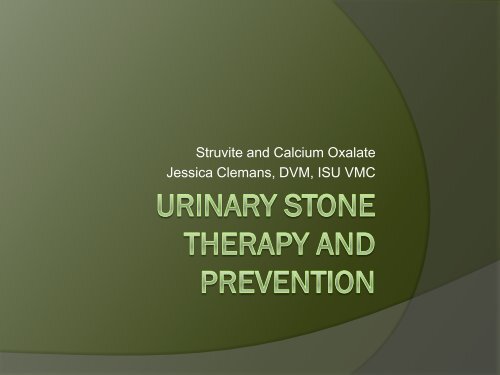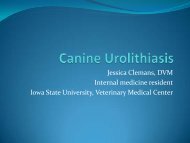Struvite and Calcium Oxalate Jessica Clemans ... - Bichon Health
Struvite and Calcium Oxalate Jessica Clemans ... - Bichon Health
Struvite and Calcium Oxalate Jessica Clemans ... - Bichon Health
Create successful ePaper yourself
Turn your PDF publications into a flip-book with our unique Google optimized e-Paper software.
<strong>Struvite</strong> <strong>and</strong> <strong>Calcium</strong> <strong>Oxalate</strong><br />
<strong>Jessica</strong> <strong>Clemans</strong>, DVM, ISU VMC
Lith= stone<br />
Organized<br />
concretions<br />
Organic Matrix:<br />
• proteins, Gag’s<br />
• DSB<br />
Inorganic Mineral<br />
(crystals) lattice<br />
Casts, epi cells,<br />
heterogenous,<br />
suture
Why Stones Count<br />
Recurrence<br />
• About 50%<br />
• Months to years<br />
Infection<br />
• Can lead to inability<br />
to clear infection<br />
• Kidney failure<br />
• Sepsis<br />
Result in kidney loss<br />
Obstruction<br />
Chronic Renal<br />
Insufficiency<br />
Acute Renal Failure<br />
Strictures
Identify the Stone<br />
Stones are not all equal<br />
<strong>Struvite</strong><br />
<strong>Calcium</strong> <strong>Oxalate</strong><br />
Cystine<br />
Urate<br />
Silica
After Identification<br />
Water<br />
Diet- emphasis<br />
Other<br />
Monitoring<br />
If you cannot remove the stones
The Key: Water<br />
Goal= Decrease<br />
concentration<br />
• Many reasons why<br />
Dry food vs canned<br />
Water dishes<br />
• Fountains<br />
Ice cubes<br />
Bottled vs. other
Medical dissolution<br />
○ <strong>Struvite</strong>, xanthine/urate, cystine<br />
○ Diet<br />
• Specific gravity<br />
• Low purines for Urates, also alkalinize<br />
- no fish or gl<strong>and</strong>s
Dietary<br />
Prescription formulas<br />
• Science Diet Hills<br />
• Purina<br />
• Waltham<br />
Must fit the stone
Diets, preventions
<strong>Struvite</strong> stones<br />
○ Culture<br />
• Complicated UTI schedule<br />
• <strong>Struvite</strong> will release new Bacteria<br />
• Treat for 1 month after radiographic<br />
resolution<br />
Treat long term<br />
• 4 total cultures<br />
• Antibiotics<br />
○ 5-6 weeks<br />
○ Or 2 weeks past x-ray changes
<strong>Struvite</strong> Diets<br />
Hill’s Science Diet c/d, w/d, s/d<br />
Royal Canin<br />
• Urinary SO, SO13, Control Formula
Basics of <strong>Struvite</strong> diets<br />
Low magnesium<br />
Low phosphorous<br />
• Low protein<br />
Low sodium<br />
• Dilute urine<br />
pH goal<br />
• 6.2-6.4
Hill’s Science Diet c/d<br />
Monitor urine pH<br />
• Should be neutral<br />
Hyperlipidemia<br />
Pancreatitis<br />
• Current <strong>and</strong> history<br />
Non-struvite crystaluria<br />
Pregnant or nursing dog<br />
Puppies<br />
Obesity concerns<br />
• w/d similar, better long term<br />
Goal<br />
Concerns &<br />
contraindications
Hill’s Science Diet w/d<br />
High fiber better for<br />
those with elevated lipids<br />
Has low magnesium <strong>and</strong><br />
phosphorous<br />
Already urine acidifying<br />
Monitor urine pH <strong>and</strong><br />
urinalysis<br />
• CaOx?<br />
• Alkaline= new infection<br />
Same life stages<br />
Concurrent use of<br />
urinary acidifiers<br />
Low weight<br />
• Debilitated<br />
Dehydration<br />
Goal<br />
Contraindications
Hill’s Science Diet s/d<br />
Acute therapy for<br />
dissolution of<br />
struvite<br />
Not meant for long<br />
term<br />
• CaOx<br />
Lowest protein<br />
• Acidifying
Hill’s Science Diet s/d<br />
Monthly Monitoring<br />
• PE<br />
• CBC<br />
• Serum chemistry<br />
• cPLI <strong>and</strong> triglycerides<br />
• Urinalysis<br />
Same life stages<br />
First 1-2 weeks after<br />
surgery<br />
Urinary acidifiers on<br />
board<br />
Use no longer than<br />
6 mo<br />
Stones that are not<br />
struvite
Hill’s Science Diet s/d<br />
Many more “No’s”<br />
• Heart<br />
• Kidney<br />
• Hypertension<br />
• Liver<br />
• Hyperlipidemia<br />
• Pancreatitis<br />
• Obese<br />
• Older than 7 yrs<br />
• Other disease<br />
• Steroid administration<br />
http://www.hillspet.com/products/prescription-diet/pd-canine-sd-caninecanned.html.<br />
4.8.10
Diets, preventions
<strong>Oxalate</strong> stones<br />
Low calcium<br />
Low protein<br />
pH target: 7.1- 7.7<br />
Hill’s Science Diet<br />
u/d<br />
Royal Canin<br />
• Urinary SO, SO 13
Hill’s Science Diet u/d<br />
Stone types<br />
• CaOx, urate, cystine<br />
Changes of note<br />
• Urine dilute<br />
• Decreased BUN<br />
Monitor 6 months<br />
• Serum chemistry<br />
• echocardiogram<br />
<strong>Struvite</strong> stones<br />
Low albumin<br />
• Protein depletion<br />
possible if used long<br />
term<br />
Added carnitine <strong>and</strong><br />
taurine due to low<br />
protein
Royal Canin Urinary SO<br />
Moderate acidic<br />
urine<br />
• pH 5.5-6.0 <br />
High volume urine<br />
• High moisture<br />
• Higher NaCl<br />
• Protein restricted<br />
Low<br />
• Magnesium<br />
• <strong>Calcium</strong><br />
• oxalate<br />
<strong>Struvite</strong><br />
• Dissolution or<br />
prevention<br />
Controversial diet for<br />
CaOx
Contraindications for Both<br />
Growing puppies<br />
Pregnant <strong>and</strong> nursing<br />
Hyperlipidemia<br />
• High triglycerides<br />
Pancreatitis<br />
• History or risk
Human Food to Avoid<br />
<strong>Calcium</strong><br />
Meats:<br />
• salmon, bologna, sardines<br />
Vegetables:<br />
• baked beans, broccoli, collards, lima beans,<br />
spinach, tofu<br />
Dairy
What to Avoid<br />
<strong>Oxalate</strong><br />
Meats: sardines<br />
Vegetables:<br />
• Asparagus, broccoli, celery, corn, cucumber,<br />
egg plant, green beans, green peppers,<br />
lettuce, spinach, summer squash, sweet<br />
potatoes, tomatoes<br />
Fruits<br />
• Apples, apricots, cherries, citrus peel,<br />
orange, peach, pear, pineapple, tangerine<br />
Various<br />
• Peanuts, cornbread, soybean, pecan, wheat<br />
germ, beer
Supportive care for all
Urine retention<br />
Access to Outside<br />
Back problems?
Why Glucosamine?<br />
Underlying defense for bladder surface<br />
Can help normal urine proteins work<br />
optimally<br />
• Proteins<br />
• Increased glucosamine = increase ability to<br />
trap bacteria
Antibiotics?<br />
When appropriate?<br />
When “blind” antibiotics not good
Antioxidants<br />
Renal protectant<br />
Omega 3’s<br />
• Fish oil
The Acidifiers<br />
Acidifying diets<br />
Chronic metabolic acidosis<br />
Cranberry<br />
Vitamin C/Ascorbic acid
Changing urine to basic<br />
Potassium Citrate<br />
• Binds Ca<br />
• Changes pH<br />
○ Less Ca in urine<br />
Science Diet ud<br />
• Supplemented already
Underlying Causes<br />
High calcium- idiopathic vs other<br />
Liver disease<br />
Causes of increase UTI risk<br />
• Diabetes mellitus<br />
• Hyperadrenocroticism/Cushing’s<br />
• Kidney disease<br />
• Structural abnormalities<br />
Immune-suppression<br />
Low phosphorous<br />
Vitamin Deficiency?
Treatments Predisposing<br />
Furosemide<br />
Prednisone/prednisolone<br />
• Steroids<br />
Vitamin D<br />
Urine acidifiers<br />
Increase calcium in urine
Vitamin B6<br />
Dogs with CaOx deficient<br />
• Miniature Schnauzers<br />
• <strong>Bichon</strong> Frise dogs<br />
• All others so far tested<br />
○ current stones<br />
○ Brussels Griffon<br />
○ Welsh Corgi<br />
○ Mixed breed<br />
○ Maltese<br />
○ Toy Poodle
Vitamin B6<br />
Other vitamin B’s<br />
• A small number tested: B 12<br />
Supplement?<br />
• Not without documented deficiency<br />
• Not without ability to monitor<br />
○ Too early to tell if effective
Life After Urinary Stones
Assuming Removal has Occurred<br />
Recheck<br />
Urinalysis<br />
• Sp gr<br />
• 3-4 months<br />
Abdominal<br />
radiographs<br />
• 4-6 months<br />
Exceptions:<br />
whenever clinical<br />
signs occur
Options for difficult situations
Removal Not Possible<br />
Recheck schedule<br />
4-6 months<br />
• Culture urine every 6<br />
months<br />
○ Treat appropriately<br />
• Renal panel<br />
Clinical signs= do<br />
sooner
Take homes for all<br />
Water intake<br />
• Increased intake= increased output<br />
○ Less chance for formation<br />
pH of urine<br />
• 7.0<br />
Monitor for complications<br />
• Infections<br />
• Obstruction<br />
• Polyps
References<br />
<br />
<br />
<br />
<br />
<br />
<br />
Appel, S.L., S. L. Lefebvre, D.M. Houston et. al. Evaluation o risk<br />
factors associated with suture-nidus cystoliths in dogs <strong>and</strong> cats:<br />
176 cases (1999-2006). JAVMA 2008; 233 (12): 1889-1895.<br />
Royal Canin Veterinary Diet Product guide. St. Charles, MO. 2005. pg<br />
68-69.<br />
H<strong>and</strong>, M <strong>and</strong> B. Novotny. 2002. Small animal Clinical Nutrition: canine<br />
urolithiasis. Pages 636-644.<br />
Osborne, C. <strong>and</strong> J. Lulich. 2009. Changing paradigms in the frequency<br />
<strong>and</strong> management of canine compound uroliths. Veterinary Clinics of<br />
North America. 39 (1):41-54<br />
Osborne, C. <strong>and</strong> J. Lulich. 2009. Veterinary Clinics of North America.<br />
39 (1): 65-92.<br />
Osborne, C., J. Lulich, J. Kruger, et al. Analysis of 451,891 canine<br />
uroliths, feline uroliths, <strong>and</strong> feline urethral plugs from the Minnesota<br />
Urolith Center. Veterinary Clinics of North America Small Animal<br />
Practice. 2009; 39 (1):184-197.



